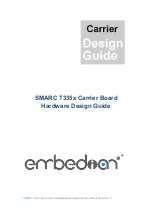
Chapter 2 – QuickCarrier USB GPRS (MT100UCC-G2)
16
QuickCarrier Developer’s Guide
Safety Notices and Warnings
Note to OEMs:
The following safety statements may be used in your final product documentation.
RF Safety
Remote modems are cellular devices. It is important to follow any special regulations regarding the use of
radio equipment due in particular to the possibility of Radio Frequency (RF) interference.
Caution:
A separation distance of at least 20 cm must be maintained between the modem transmitter’s
antenna and the body of the user or nearby persons. The modem is not designed for or intended
to be used in portable applications within 20 cm of the body of the user. Check your local
standards regarding safe distances, etc.
●
Operating a cellular modem close to other electronic equipment may cause interference if the
equipment is inadequately protected. Observe any warning signs and manufacturers’
recommendations.
●
Different industries and businesses have their own restrictions governing the use of cellular devices.
Please observe local restrictions of the environment where you intend to operate the cell modem.
●
Under no circumstances should the antenna be placed outdoors.
Interference with Pacemakers and Other Medical Devices
Potential interference
Radiofrequency energy (RF) from cellular devices can interact with some electronic devices. This is
electromagnetic interference (EMI). The FDA helped develop a detailed test method to measure EMI of
implanted cardiac pacemakers and defibrillators from cellular devices. This test method is part of the
Association for the Advancement of Medical Instrumentation (AAMI) standard. This standard allows
manufacturers to ensure that cardiac pacemakers and defibrillators are safe from cellular device EMI.
The FDA continues to monitor cellular devices for interactions with other medical devices. If harmful
interference occurs, the FDA will assess the interference and work to resolve the problem.
Precautions for pacemaker wearers
If EMI occurs, it could affect a pacemaker in one of three ways:
●
Stop the pacemaker from delivering the stimulating pulses that regulate the heart's rhythm.
●
Cause the pacemaker to deliver the pulses irregularly.
●
Cause the pacemaker to ignore the heart's own rhythm and deliver pulses at a fixed rate.
Based on current research, cellular devices do not pose a significant health problem for most pacemaker
wearers. However, people with pacemakers may want to take simple precautions to be sure that their
device doesn't cause a problem.
●
Keep the device on the opposite the side of the body from the pacemaker to add extra distance
between the pacemaker and the device.
●
Avoid placing a turned-on device next to the pacemaker (for example, don’t carry the device in a shirt
or jacket pocket directly over the pacemaker).
Vehicle Safety
●
Do not use your cellular device while driving. Respect national regulations on the use of cellular
telephones in vehicles. Road safety always comes first.
Содержание QuickCarrier USB MT100UCC Series
Страница 1: ...QuickCarrier USB MT100UCC Developer s Guide ...
Страница 24: ...Chapter 2 QuickCarrier USB GPRS MT100UCC G2 24 QuickCarrier Developer s Guide Mechanical Drawing ...
Страница 29: ...Chapter 3 QuickCarrier USB HSPA MT100UCC H5 QuickCarrier Developer s Guide 29 Mechanical Drawing ...
Страница 36: ...Chapter 4 QuickCarrier USB EV DO MT100UCC EV2 36 QuickCarrier Developer s Guide Mechanical Drawing ...









































